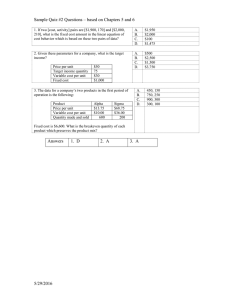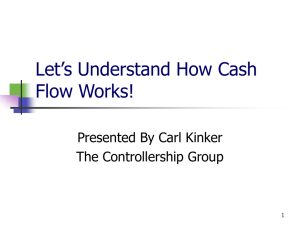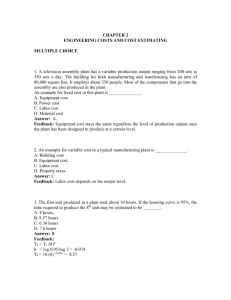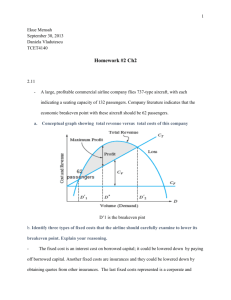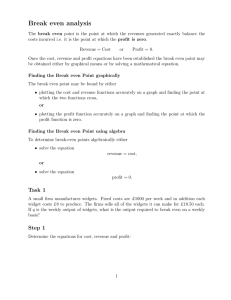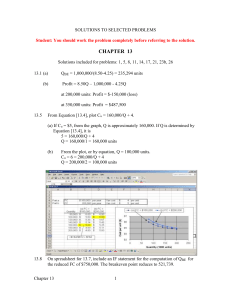-
advertisement
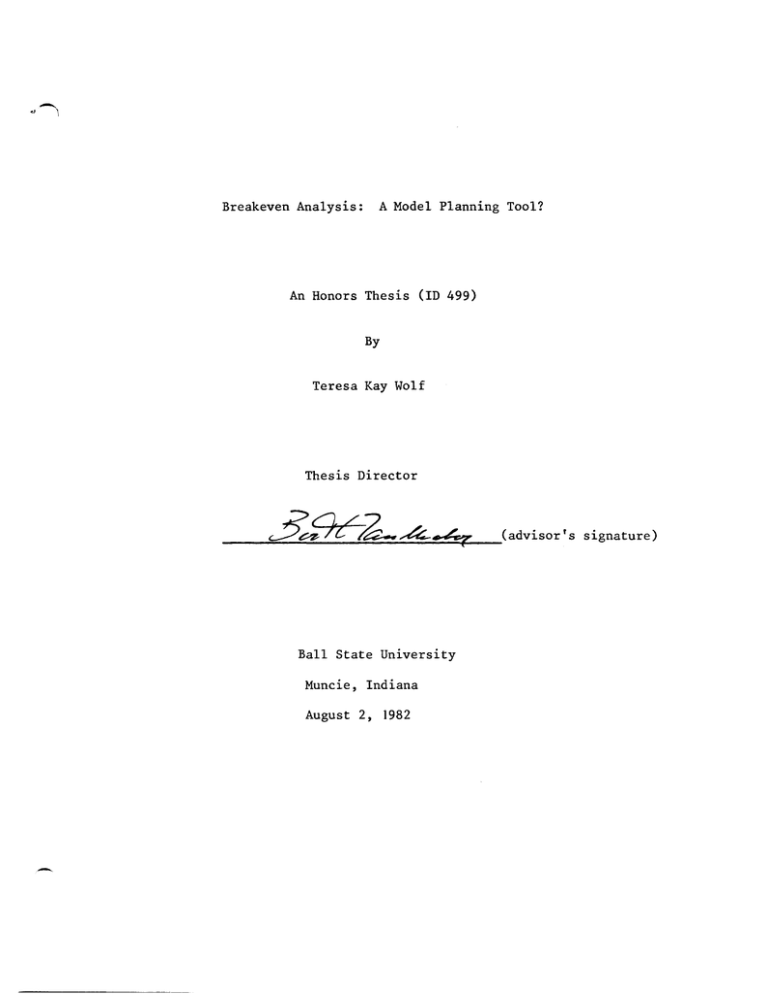
.,
-
I
Breakeven Analysis:
A Model Planning Tool?
An Honors Thesis (ID 499)
By
Teresa Kay Wolf
Thesis Director
__
- . .: ~:;: ; ;. - : ;~. :9~_z_/_. :.:~=. ; ;. ; ;. ;. ~. ._. ; ; ; ;. .: ;_ 4r;. ; . .: ~- ( advisor s
r
Ball State University
Muncie, Indiana
August 2, 1982
-
signature)
Sf~11
-rn('<; s
L I)
,()YSJ
-
,2'-+
I.08~
In today's dynamic world economy, the United States maintains a perilous
position--perched on the brink and faced with the prospect of falling off its
pedestal as the world leader in technology, innovation, and in a sense industry
itself.
Its slightly tarnished image as the world economic power is most readily
apparent in its recent setbacks in the world trade arena, as the trade deficit
continues to mount, and the U.S. competitive position is being challenged by
external powers as never before.
The United States's ability to respond to such a challenge has been equally
hampered by its internal economic woes.
The Reagan and Carter administrations,
as with their predecessors,have been faced with the seemingly insurmountable
task of controlling inflation and unemployment in the light of this most delicate
position of U.S. business and industry.
With controversy over the economic
policy to be employed for the 80's--demand versus supply-side--progress has been
limited even more as power struggles between both camps have hampered productive
strategy developments.
These events have in many ways changed the very course of the U.S. economy.
It has within the last century undergone three distinct and varied changes in
response to these external and domestic conditions.
Our economy has changed
from a labor-intensive, agricultural based economy in the early twentieth century to a capital-intensive, manufacturing based economy in the mid twentieth
century to an information-intensive, technology based economy in the late twentieth century.
These changes in emphasis have had a profound
effect on those
basic factors of production postulated by David Ricardo or land, labor, capital
and the talent of Joseph Schumpeter's innovative entrepreneur, without which
productive enterprise would not take place.
Employment statistics alone illust-
rate this trend within our economy and its effect on labor, as employment in
agriculture has given way to a surge of employment in manufacturing which has
in turn lowered in favor of an emphasis in the service sector.
Estimates of
the capital investment per worker in each of these sectors ha~ also given us
insight into the movement within our economy.
There has been much speculation on the part of economists and business
researchers alike as to what the primary motivational force
might actually be.
behind this trend
Much current thought on this issue deals with the increasing
advent of high technology and know-how which, in and of itself, has broad implications for U.S. business managers and the decisions they make.
John Kenneth Galbraith, in his book The Industrial State (1969),witnessed
this shift in our economy and viewed it as a necessity arising for& the complex
components of modern society.
Galbraith realized the advantage of "dividing
and subdividing the component parts of industry and of the systematic application
of knowledge to those various areas," yet he also recognized the impact on business
decision-making and processes of such an advancement, which he outlined and
1
referred to as the six consequences of the imperatives of technology. The first
consequence, as he saw it was a marked increase in the span of time between
the beginning and end of a project or task.
The more advanced the technology
involved in such a venture, the more rigorous and time consuming becomes the
processes to be completed before its conclusion.
As any manager will readily
recognize, time is money, and extra time spent on project completion not only
has direct costs, but opportunity costs as well.
Indeed today's manager has
witnessed this phenomenon in his own operations.
The second consequence of technology according to Galbraith is an increase
ln the amount of capital used in the production process.
In competitive
industries, the need to innovate indeed becomes a survival need for most firms,
-
and innovation has its price.
In attempt to improve production processes for
(2)
quicker manufacturing turnover and less costly methods of manufacturing commodities, the necessary investment in capital equipment becomes apparent.
It
is simple en.ough to see the increase in expenses as a result of this additional
investment, yet less apparent is the cost of the technoloy or know-how which
goes into the construction of such equipment or the development of new techniques to 1mprove outdated ones.
The advances we are witnessing in American
Industry today are indeed costly 1n many respects.
Many hours are spent in
research, sometimes fruitless, before just the right combination of factors
is put together in such a way as to answer industry problems.
The third consequence of this new technology is the ensuing inflexibility
of business decisions as investment in time and capital increases.
It soon
becomes much too costly a proposition to terminate a project after much time
and money has been expended on its behalf, regardless of what external factors
have prompted such a proposal.
This increases the risk factor inherent in all
such ventures, and changes management's outlook or perspective on project proposals.
Another resultant consequence of technology 1S the need for more specialized
and trained personnel to deal with these changes within the firm.
This is not
only that manpower involved in the actual technical process, but also those
individuals responsible for the planning and control of the firm.
As the
elements brought to bear on the decision making process become increasingly
more complex, these individuals must be highly trained, skilled, and experienced at what they do.
Mistakes become costly and precision is vital.
The "inevitable counterpart" of such specialization is organization,
which is the fifth consequence of the imperatives of technology as postulated
by John Kenneth Galbraith.
Most scholars and managers alike would recognize
this as a typical if not invariable response of business to deal with the
(3)
complicated procedures implied by new technology.
Staff and paperwork 1n-
crease as a function of the complexity and risk introduced by change.
Whether
an increase in "organization" is a benefit or detriment to American industry
is beyond the scope of this paper. (Let it be said, however, that in the view
of this author, much can be said for simplicity.)
Out of all of these consequences exposited thus far:
increased commL,:-
ments of time and capital, the inflexibility of such committments, necessity
of
speciali~~ed
manpower, and the need for the development of large organization,
comes the final and perhaps most significant of all--the necessity for planning.
Changing technology does indeed dramatically alter what can be obtained from
any given supply of factors (land,labor, capital, and entrepreneurial ability),
yet " ••• at any time, there will be a maximum obtainable amount of product for
any given amount of factor inputs ••• ,,,2 which indicates that the idea of comparative advantage, as put forth by Ricardo, is intimately intertwined with
successful planning.
In as much as capital budgeting is the allocative process
by which the resources of the firm (or factors of production) are applied to
various ventures, the method by which this is accomplished should be the very
heart of planning within the firm.
Managers, as a result of the dynamic nature of business enterprise today,
must learn to project the planning process well into the future in order to
effectively evaluate appropriate technology
to ten year time span.
~
to be utilized within a five
It is on this aspect of business management that the
future of American industry hinges.
It has been shown that those countries
with superior planning skills in this area have succeeded in maintaining high
levels of growth due to their emphasis on the long range planning process as
opposed to the realization of short term goals.
If America is to be competitive
with such countries, and to regain its former comparative advantage in industry
.-
more attention must be devoted to productive investment through effective
capital budgeting measures in light of long term goals and;improved techniques
to aid in such a process.
It is this very topic to which I shall address the
remainder of this paper.
Long range planning within the last fifteen years has received widespread
acceptance from most major U.S. firms and is utilized, in fact, rather extensively in large corporations, as was discovered by Toyohiro Kono in his comparative study of long range planning in the U.S.A. and Japan.
Kono found that
more than 80 percent of large U.S. corporations have some type of long range
plan for their enterprise, and that they felt it necessary "for better allocation
of resources."
3
Japanese firms also value planning within their operations, as
77 percent of their large corporations have a long range plan.
for planning, however, is slightly different.
Their reasoning
Long range planning Japanese style
is "used to improve the decision at the top,"4due to the fact that top management
and the planning department play the most important role in strategic decision
making.
Both the U.S. and Japan stress project evaluation as the key factor in
the planning process (as opposed to quantitative techniques), yet American firms
report a more closely controlled follow-up procedure.
These U.S. firms updated
their plans at regular intervals and adopted contingency plans to accomodate
changes in the external environment, while Japanese managers were found to be less
likely to
stick closely to the plan itself but rather attempted to implement it
through budgeting and project planning.
Although there are slight deviations
of these
countrie~
~n
the way planning is viewed in each
the processes are also very similar between them.
If this is
in fact the case, why are the Japanese continuously praised for their planning
efforts, and seemingly more successful at it?
(5)
Looking more closely at the components of the long range plans (LRP's)
used by U.S. and Japanese firms (refer to endnotes), a striking dissimilarity
can be seen in the emphasis given to various elements of the LRP itself.
Japanese firms have consistently responded in Kono's survey more to those
elements of the LRP germane to the essential structuring of a synergistic
firm--that is:
manpower planning (as well as education and management devel-
opment), capital investment in light of cost reduction, and environmental
forecasting.
In contrast, most American firms placed their primary emphasis
on the estimated profit and loss statement and estimated flow of funds.
This
would tend to support conjecture on the part of financial experts and economists alike as to the true motivational force behind decision making in the
United States.
Are our managers really only interested in short run profit?
Any principles textbook in the area of finance will tell you from the
onset, by way of assumption, that the goal of management should be to maximize
the wealth of the stockholder rather than attempting to maximize profit.
In
fact, it is typically maintained that the two goals are, indeed, mutually exclusive, and that only the goal of shareholder wealth maximization will ensure
the survival of the firm.
so preoccupied with profit?
If we assume this to be true, why then are managers
Indeed, profit is essential to all firms for sur-
vival so in a sense interest in securing a profit is warranted, yet especially
in our current inflationary cycle, much harm can be done to those firms overly
preoccupied with profit and loss reported on financial statements.
According to the National Machine Tool Builders' Association President
James A. Gray,"For too long in American industry we have focused on public
reports of phantom profits and avoided reading between the lines." SIf management
were to read between the lines of public reports they would find a grossly
misconstrued profit figure as a result of the ravages of inflation on the two
(6)
most important elements in profit calculation--sales and costs.
The cost figures
are most drastically changed by the impact of inflation in that inventories
and depreciation expenses are mistated-- due to replacement costs and the method
of depreciating equipment respectively.
When traditional accounting techniques
and figures are used, many financial analysis techniques utilizing these figures
can be decei.ving, causing even some inadequate projects to look great. "But
that company also would be on its way out of business," Mr. Gray also pointed
out,"The point is, conventional accounting methods discourage capital investment.,,6
And
managemen~s
reliance on profit considerations and just such figures decreases
their effectiveness as decision makers and can cause a great deal of harm to
their operations.
Even the financial analysis techniques mentioned above for the allocation
of resources within the firm, are not indicative of those you would expect to
be used in prompting decisions by management for the maximization of shareholder
wealth.
Instead they all tend to result in decisions aimed at maximizing the
profit accruing to the firm without regard to other factors.
It is only natural
that managers are constantly conscious of profit as management in the U.S.
rewards its managers to a great extent on the basis of project profit.
Decision
makers attempting to improve their record with the company are reinforced in
the use of techniques such as ROI, Payback, IRR, NPV, and DCF as conclusive
basis for capital budgeting.
These tools are not inherently misleading in terms
of undermining the competitiveness of the firm, yet they are often employed
in such a way, in that those projects yielding the highest IRR or NPV, or perhaps
with the quickest payback will be selected for funding regardless of their implications for the long range position of the firm.
In short, productive invest-
ments often fall by the wayside as a result of a mere manipulation of numbers.
The United States government itself is a major contributor to the short
(7)
term thinking pervading business thinking as it oftein discourages the productive capital investment necessary for U.S. industry to prosper admidst its
competitors.
The flat-rate investment credit available for most equipment
purchases, for example, favors short-lived over long-lived investment, as it
lowers the effective tax rate more for those types of investments.
7
As a result,
those industries which use predominantly short-lived equipment (construction,
and motorized vehicles) are subsidized to the detriment of those requiring
relatively long-term investments(primary metals, communications, and utilities).
It is by such a mechanism that U.S. investment dollars are being funneled into
decaying industries and least productive uses.
Toru Nakamura, in his article "Productivity Losses through Capital Misallocation in the U.S., Japan, and West Germany,"S found substantial governmentinduced bias in the allocation of capital in the U.S.
This bias was exemplified
through favorable taxation of owner-occupied housing and the double taxation
of corporate income, and has caused pronounced "inefficiency, measured by the
extent of U.S. productivity losses."
These inefficiencies, though existent,
are small in Germany and negligible in Japan.
One explanation for the efficiency in Japanese capital allocation rests
1n the role the Japanese government plays in the capital market.
In his study
of "Equity Financing and Gearing in the U.K., U.S., Japan, and Israel,"
Meir
Tamari noted that "Public policy 1n Japan ••• increases the availability of funds,
lowers the cost of borrowing, and limits the loss to the lender," all of which
provide an atmosphere conducive to investment for business, and in turn encourages
innovation. 8 The net cost of owner--occupied housing in Japan is also maintained
at a level higher than the net cost of business capital, which indicates the
importance Japanese society places on business investment relative to family
-
housing.
(S)
These results tend to imply that capital formation in the U.S. could also
be made more productive if the net cost of owner-occupied housing is raised,
while that of business capital is lowered.
The Economic Recovery Tax Act of
1981 has made great strides toward this end (at least toward relieving the bias
we spoke of earlier), with its provisions for a revamping of the capital gains
tax system, and a rapid capital recovery program to replace the
slow depreciation process.
~previously
Indeed under the old depreciation schedules, it
would have been quite concievable that a company investing in new plant and
equipment to/day could see anywhere from two to four rollovers in technology
before those investments would reach obsolescence by government standards.
As
a tax deductible expense, depreciation is, in a sense, a form of government
subsidy.
be
There are no "natural laws" as to how depreciation
s~~eduled
occurs or should
for--it should, however, reflect the intent of the government
granting the subsidy and the changing needs of business and industry.
Such a
realization on the part of U.S. leaders has been long overdue, and has layed
the groundwork for more cooperation between business managers and their governmental counterparts.
Regardless of these positive changes from the advent of Reaganomics, much
conflict is yet to be resolved between the long term direction of governmental
policies and the short run methods of achieving them.
The tight money policies
espoused by Paul Volker have been wreaking havoc on the incentive of U.S. business and industy to assume the risk of innovation amidst high interest rates
and instability.
Those firms willing to take such a risk often find themselves
in a position which necessitates an increase in price in order to cover increased
fixed cost.
This serves to effectively lower cost competitiveness, in an economy
already suffering from decreases in demand.
Such a risk then might well cause
a firm to price themselves out of their market, especially in light of the
(9)
foreign competitive threat.
Japanese manufacturers are able to slash their
prices on particular exports to levels not even imaginable by many
due to extensive government protection and subsidies.
u.s.
firms
This "dumping" of
Japanese goods on American markets does little to convince American managers
of the necessity of productive investment as survival itself appears tentative
in the short-run.
U.S. managers must, however, learn to do more than profess
the desire for long run viability in world markets.
They must take active
measures toward such a goal by developing policies and tools aimed at the
maximization of shareholder wealth.
For if they do not, they will truly be
denying their raison d'etre.
Techniques now in existence not only have profit-maximizing implications,
but are basically shareholder oriented in perspective.
Managers must have
a management tool with which to tune the machine of capital budgeting and
expenditures in view of the complexity of factors coming to bear on each and
every decision.
Those budgeting tools most frequently used by business managers are ROI,
Payback, and net present value techniques.
9
These methods of project analysis
have led managers to make positive investment decisions most frequently when:
1) the payback period is short, 2) the ROI is high, 3) the investment would
require the use of a proportionately small amount of the funds available to
management, and 4) when the risk that would be undertaken by the project is
not large.
10
The danger in this type of outlook on investment is not readily
apparent, as each of the above stated criterion would tend to emphasize the
characteristics that an ideal investment should possess.
All managers would
without doubt prefer an investment that would require limited funds, yet yield
a high return, in a relatively short period, with little risk.
is money, and profit is in the bank.
( 10)
After all, time
What such a limited analysis belies is
what we spoke of earlier as the process by which productive investment decisions
are often overlooked.
Investments for the future are often more costly, more
risky, and (in the short run) yield little profit.
Typical evaluation criterion
are not equipped to take into consideration such vital factors as these.
With
the business environment what it is today, business managers must be constantly
aware of the changing external factors influencing their business enterprise
in order to prepare themselves for whatever contingencies should develop.
Per-
haps even more crucial to meeting those external challenges, however, is a
superior understanding of the internal operations of their organizations Ln order
to more successfully plan a course of action.
Sensitivity analysis has in recent years experienced a surge of popularity
as managers are attempting to combat uncertainty through this form of risk
analysis.
Statistics haven't necessarily reflected this trend,however, Ln many
cases due to the fact that firms do not even know that what they are in fact
undertaking is called "sensitivity analysis."ll
Sensitivity analysis in its simplest form is a reference to the process
by which variables and assumptions are changed to determine their impact on
the profitability of the firm.
It can take on many complex forms with the use
of computers, such as in David Hertz' Monte Carlo simulation.
Monte Carlo simulation involves 1) developing a model of the project, 2)
specifying probabilities for each of the determinants of cash flow, 3) and
directing the computer to assign values to each of
the~
determinants and to
assess cash flows that would result from all possible scenarios.
This algor-
ithmic problem solving model sounds ideal, but most firms would probably find
it much too costly to develop originally and to keep up-dated as the inputs
would be dynamic and difficult to maintain.
A great deal of skill is also
necessary for the implementation of such a process as even a slight error in
( J J)
inputs or the initial model would drastically impair its usefulness.
Although a useful "laboratory tool," it would be misleading to assume as
many do that a model to accurately and precisely describe all uncertainties
and interdependencies could actually be developed.
Models such as Monte
Carlo simulation do hold much promise for the future as more and more business
firms will have the excess computer capacity and funds to afford such and
undertaking, and the skills required to make the most of what is available
in terms of information inputs and outputs, but from this author's point of
view it is not a practical tool for general business enterprises.
Although we must accept imperfection in regards to building a model financial planning methodology, there are still some points on which we must
maintain a level of high expectation.
That is we
ar.e still able to outline
those qualities essential for a paradigm of planning.
Most obviously, the
model planning tool must be effective while not too complex to be practical
for all business managers to use, regardless of the size of their organization.
It must also be relatively inexpensive
and flexible enough to use in evaluating
environmental, governmental, and technological changes.
In order for our model
tool to have relevance today, productivity considerations must be able to be
incorporated into its use.
And finally, it must be consistent and adequately
able to integrate with existing sophisticated numerical analysis in project
evaluation.
While this synthesis of a planning paradigm may to most seem simultaneously
simplistic and inattainable, it serves to set the framework within which all
possible offerings must be evaluated.
Indeed, it has served to tighten the
perspective of this author in her search for a suitable tool for management's
use in capital planning for productivity and growth.
After a diligent search of the literature a rather startling and unlikely
(12)
-
candidate for such a position remained as the best fit to the framework established above--BREAKEVEN ANALYSIS.
This seemingly forgotten form of sensitivity
analysis goes a long way toward yielding short-run answers that make long-run
sense.
Breakeven Analysis is an analytical technique used in studying the relationships among fixed costs, variable costs, and profits.
These relationships are
most typically illustrated in the form of a graph or chart, much as the figure
below:
INCOME
NET PROFIT
VARIABLE COSTS
100
I
t-
/
,/
i
I
BREAKEVEN POINT
I
//
iL-~~/ ______~_--.~
1·/
_________________. . .
.
J
FIXED COSTS
I
:
I
l
I
-------t
so
The breakeven point occurs at that point at which sales will just cover
total costs, when total cost is equal to variable plus fixed costs.
This point
is particularly important to management as up to the breakeven point the firm
suffers a loss, while after that point a profit begins to accrue to the firm.
Fixed costs remain relatively constant through time and do not vary with
(13)
production.
Some typical elements of fixed cost are depreciation on plant and
equipment, interest charges on debt, rentals, salaries (executive), and general
office expenses.
Variable costs, on the other hand, do vary with production
levels, and include such items as factory labor, materials and sales commissions.
One key assumption in this type of analysis is that those relationships
being examined--name1y between cost, volume, and profit--can be expressed as
a linear approximation of what may more realistically be curvilinear cost and
price functions.
This approximation can be used without significant loss of
accuracy, however, due to the fact that, within a relevant range, levels of
production do maintain a level of constancy.
With some modifications the model
can also be constructed to be used in those situations demanding a higher degree
of realism.
Breakeven analysis is most often used in budgeting, new product, and pricing
decisions.
It has most often been considered a short-run tool for financial
analysis, yet this author would argue its viability as a long range methodology.
Critics of this viewpoint might sight a number of rough spots in the process
of breakeven analysis as reason for its dismissal, yet many of these seemingly
insolvable problems have within the last several years been smoothed away by
innovative reasearch in this area.
An example of this is seen in the difficulty
in measuring output and relating it to costs when a firm has a variable product
mix, which was alleviated by the development of the technique by which each
product or component within the product mix is weighted by the use of a physical
production index.
Breakeven analysis is not without its limitations, but much
has been done toward its
refinement within
the last half of the century.
It
can naw be used with both direct and absorbtion costing systems, modified to
take inflation (both linear and compounded) into consideration, as well as
random demand and the level of production used in the determination of actual
(14)
sales and profits-all thought to be insurmountable drawbacks to its use.
Another consideration in this conflict of views is the nature of the
cost and profit relationships of the firm.
Information about future relat-
ionships between there items would be impossible to speculate on with absolute
accuracy and BE analysis naturally relies on that information available to
us through current operating data, and in some instances, historical input.
Although those who view BE analysis as only being useful in the short-run
would emphasize that this point alone illustrates it would not be an effective planning tool, its purpose is forward-looking, as it is designed to aid
in making
~
decisions for the future.
No planning tool will be able to
forecast future events with total accuracy and BE is no exception.
BE analysis is, however, a very useful tool for management's use in understanding business operations, their environment, and the implications of their
business decisions, despite its weak points.
It is based on very fundamental
business relationships which managers find easy to work with, yet insightful.
The input data, although often requiring a great deal of effort to compile,
is composed of those things which firms have available to them,to a large
extent due to the requirements of financial accounting.
This makes the devel-
opment and up-dating of breakeven less difficult than with other models, and
it can be used as a common basis of discussion on all levels of management
and between virtually all departments.
It is for all of these reasons that it is a comparatively inexpensive
tool which makes it equally feasible for a small business as for a large corporation.
For those organizations which have existing computer capacity sufficient
to handle necessary computations, BE analysis is painless to construct.
does not rely on such equipment, however.
( 15)
It
-
Breakeven analysis is also very flexible.
It can be used in a variety of
different capacities, as it can yield information useful to pricing decisions,
help determine the feasibility of new products, including financing considerations} and forecast profit at various levels of sales for existing products.
With special adaptations , it can also incorporate rate of return planning
into the analysis and aid in setting volume-sensitive ROI targets based on
return on new assets.
12
As you can see, it also works well in conjunction with,
and 1n addition to, existing numerical measures of project performance.
Breakeven is
~
go decisions are made.
designed to be a conclusive measure upon which go or noIt does, however, help to clarify relationships,
assumptions, and the impact of our environment-all essential to any good decision.
In fact, in current literature while much research has been done on
sophisticated numerical analysis techniques aimed at improving project ranking
and justification, little emphasis has been placed on this crucial aspect of
the decision making process.
In the words of K. Larry Hastie, "What is needed
are approximate answers to the precise problem rather than precise answers to
approximate problems," and that in a nutshell is what BE analysis provides. 13
Productivity of investments can also be measured by utilizing breakeven analysis.
Those investments which effectively increase fixed cost and
lower variable costs to a significant degree, make the firm more competitive
and more productive.
These changes enhance the viability of the firm thereby
Q.
increasing shatholder wealth.
Thus, breakeven analysis helps to promote the
necessary objective of the maximization of shareholder wealth which we spoke
of extensively in our earlier remarks.
Although it may not justify those pro-
jects whose benefits are not fully realized during the frame of time established
for breakeven analysis, this simple rule can give managers a reference by which
to make such a judgement in the long run.
(16)
with a little effort devoted to breakeven analysis on the part of
financial
experts~
even more modifications could not only eliminate its weak-
nesses, but make it a virtually indispensable planning tool.
Indeed, break-
even analysis has been overlooked far too long as an extremely useful tool
for management in understanding their firms' business operations, their environment, and the implications of their business decisions.
In making management
aware of such things, it paves the way toward more effective and productive
long rmgeplanning, which would serve to increase those firms' competitiveness
and through a combined effort--U.S. competitiveness as well •. That, after all
is the bottom line.
(17)
"ENDNOTES"
.-
COMPONENTS OF LONG RANGE PLANS
;'~
U.S.
Japan
Environment forecasting
48
74
Analysis of the company strengths and weakness
48
58
Forecasting the future of own company under present
policy
48
42
Problems and opportunities of the company
65
40
Mission and objectives of the company as a whole
52
Goals and policies of long range plan
48
Diversification
39
30
Internal new products development
35
53
Company acquisition
39
2
Research and development
35
37
New market development
57
26
Multi-national management
13
23
Strengthening the marketing competitive power
30
37
35
53
17
25
95
~ost
reduction plan
Computerization plan
Others
4
Sales plan (marketing plan)
74
67
Production plan
35
67
78
90
Investment subsidiaries
35
39
Material plan
17
26
*Capital investment
COMPONENTS OF LONG RANGE PLANS CONTINUED
-
U.S.
Japan
52
86
Education and management development
13
23
Employee welfare
9
12
Planning of organization
26
26
*Estimated profit and loss statement
87
70
*Estimated flow of funds
83
72
balance sheet
78
49
Assignment of responsibility
22
25
Schedule of programme
35
Unsolved problems
22
25
Contingency plans for adverse situations
57
4
*Manpower plan
1~Estimated
**All figures expressed in percentages.
FOOTNOTES
1.
Galbraith, John Kenneth, The Industrial State, (Boston: Houghton Mifflin
Co., 1969), p. 13.
2.
Samuelson, Paul A., Economics, Sixth Edition (New York: McGraw, 1964), p. 516.
3.
Kono, Toyohiro, I1Long Range Planning--Japan-U.S.A.--A Comparative Study,11
Long Range Planning, October, 1976, p. 70.
4.
Ibid
5.
Iron Age, November 23, 1981, p. 57.
6.
Iron Age., November 23, 198 1, p. 58.
7.
Nakamura, Toru, Quarterly Review of Economics and Business, vol. 21, No.3
Autumn 1981, p. p. 69.
8.
Tamari, Meir, I1Equity financing and Gearing
Israel,11
9.
Greenburg, Joel S., Investment Decisions, The influence of Risk and Other
Factors, (New YorK! Research and Information Service, American Management Associations, 1982), p. 42.
~n
the U.K., U.S., Japan, and
10.
Ibid, p. 6.
11.
Hastie, K. Larry, IIOne Businessman's View of Capital Budgeting,11 Financial
Management, Winter, 1974, p.41.
12.
Lambix, Robert J. and Singhvi, Surendra S., '~ow to Set Volume-Sensitive
ROI Targets,11 Harvard Business Review, March-April 1981.
13.
Hastie, K. Larry, 110ne Businessman's View of Capital Budgeting," Financial
Management, Winter, 1974, p. 43.
,-BIBLIOGRAPHY
-
I.
Bowen, "How to Regain our Competitive Edge," Fortune, 9 March 1981,p. 74-8.
2.
Brigham, Eugene F., "Hurdle Rates for Screening Capital Expenditure Proposals,"
Financial Management, Autumn 1975, p.17.
3.
Cox, William A., "Investment Incentives Could Enhance Recovery and Boost
Long-run Productivity," Business America, 8 September 1980, p. 18-19.
4.
Dean, Joel, "Cost Structures of Enterprises and Breakeven Charts," American
Economic Association, 1948, p. 153.
5.
Dhvale, Dileep and Hoyt G. Wilson, "Breakeven Analysis with Inflationary
Cost and Prices," Engineering Economist, Winter ] 980, p. 107-21.
6.
Faulhaber, Bert C., "Capital Budgeting for Productivity Growth," Midwest
Finance Association: Chicago, Illinois, 3 April ]982.
7.
Galbraith, John Kenneth, The New Industrial State, Boston:Houghton Mifflin
Co., 1969. p. 13.
8.
"Gray:Reinvestment
1981, p. 57-58.
9.
Greenburg, Joel S., Investment Decisions, New York: American Management
Association, 1982. p. 6.
10.
Greenwald, Carol S., "Tight Money Won't Work," Harvard Business Review,
March/April 1980, p. 122-9.
11.
Greenwood, Mary Ann, "Case for a Technologically Significant Capital Stock,"
Business Economist, January 1981, p. 94-96.
12.
Gritta, Richard D., "Effect of Financial Leverage on Air Carrier Earnings:
A Breakeven Analysis," Financial Management, Sunnner ]979, p. 53-60.
13.
Grossman, Steven D., Charles W. Plum, and Robert B. Welker, "New Dimensions
to the C-V-P Technique," Managerial Plan, March 1979, p. 35-38.
]4.
Hastie, K. Larry, "One Businessman's View of Capital Budgeting," Financial
Management, Winter ]974, p. 36.
]5.
Hawk, Steven L. and Charles O. Kroncke, "Breakeven Concept: A Guide to
Profitable Decision Making," Managerial Plan, May 1977, p. ] 1-14.
1.S
the Key to U.S. Competitive Edge," Iron Age, 23 November
,-
-
]6.
"Integrating ROI and Cost-Volume-Profit," Management Accounting, April
]98], p. 33-39.
17.
"Investment for Productivity Growth Subject of New Congressional Study,"
Monthly Labor Review, October ]981, p. 38-40.
18.
Kelly, Lawrence, "Theory, Pitfalls and Payoffs of Long Range Planning,"
Managerial Planning, May/June 1977, p. 1.
19.
Kempster, John H., "Breakeven Analysis-Common Ground for the Economist
and the Cost Accountant," N.A.C.A. Bulletin, 15 February ]949, p. 71].
20.
Kono, Toyohiro, "Long-Range Planning--Japan-U.S.A.--A Comparative Study,"
Long Range Plan, October ]976, p. 61-71.
2].
Lambrix, Robert J. and Surendra S. Singvi,"How to Set Volume-Sensitive
ROI Targets," Harvard Business Review, March/April ]981, p. 174-9.
22.
Malik and Karger, "Does Long-Range Planning Improve Company Performance?"
Management Review, September 1975, p. 27-31.
23.
McMillan, Charles and Dezso Horvath, "Industrial Planning in Japan,"
California Management Review, Fall 1980, p. 11-21.
24.
Nakamura, Toru, "Productivity Losses Through Capital Misallocation in the
U.S., Japan, and W. Germany," Quantitative Review of Economics and
Business, Autumn ]981, p. 65-76.
25.
Naylor and Schauland, "Survey of Users of Corporate Planning Models,"
Management Science, May 1976, p. 927-37.
26.
Samuelson, Paul A., Economics, Sixth Edition, New York: McGraw, 1964. p. 516.
27.
Saunders, Norman C.,"The U.S. Economy Through 1990-An Update," U.S. Bureau
of Statistics, August 1981, p. ]8-27.
28.
Shih, Wei, "General Decision Model for C-V-P Analysis Under Uncertainty,"
Accounting Review, October 1979, p. 687-706.
29.
Tamari, Meir, "Equity Financing and Gearing 1n the U.K., U.S., Japan, and
Israel," Management International Review, Vol. 3 p. 80-98.
.-
